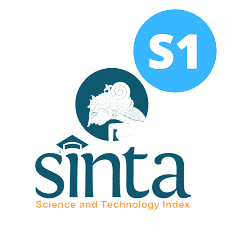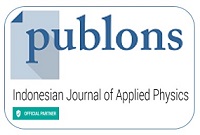Performance Analysis of EPC Material as a Kidney Organ Phantom with Exposure Voltage Variations and PA-GF-Based Kidney Stone Size
Abstract
Research in the field of radiodiagnostics has been extensively developed, creating the need for substitute objects to represent human organs—namely, radiological phantoms. A phantom is a simulated model of an organ fabricated using 3D printing technology. This study aims to evaluate the suitability of Expanded Polyamide – Glass Fiber (EPA-GF) as a kidney stone phantom material embedded within a kidney phantom, based on parameters such as material density, CT number, electron density, and radiation dose across various CT scan exposure voltages. The phantom samples were printed using a dual-extruder 3D printer, with Expanded Polycarbonate (EPC) used as the kidney phantom material. CT scan exposure voltages were set to 80 kV, 100 kV, and 120 kV. Kidney stone sizes used in this study ranged from 1 mm to 8 mm (1 mm, 2 mm, 3 mm, 4 mm, 5 mm, 6 mm, 7 mm, and 8 mm). The measured density of EPA-GF was 1.51 ± 0.06 g/cm³. The CT numbers obtained at each voltage were 373.30 HU, 329.05 HU, and 299.46 HU, respectively. The corresponding electron density values were 1.231, 1.210, and 1.196, respectively. The effective doses measured at each voltage were 0.0240 mSv, 0.0448 mSv, and 0.0798 mSv. All parameter values were found to be closely aligned with literature references. The smallest visible kidney stone size detected was 2 mm.
Keywords
Full Text:
PDFReferences
[1] X. Zheng, Y. Wu, L. Huang, and J. Xiong, “Trajectories of body mass index and incident kidney stone disease: a prospective cohort study in Chinese young adults,” Urolithiasis, vol. 52, no. 1, p. 118, Aug. 2024, doi: 10.1007/s00240-024-01617-9.
[2] M. Wang et al., “Association of health-related quality of life with urinary tract infection among kidney stone formers,” Urolithiasis, vol. 52, no. 1, p. 103, July 2024, doi: 10.1007/s00240-024-01601-3.
[3] H. Nurvan et. ,. al., “Radiology as a support for examination and treatment in the medical world and its effects: literature review,” Sci. Midwifery, vol. 11, no. 3, 2023.
[4] C. Stengl et al., “A phantom to simulate organ motion and its effect on dose distribution in carbon ion therapy for pancreatic cancer,” Phys. Med. Biol., vol. 68, no. 24, p. 245013, Dec. 2023, doi: 10.1088/1361-6560/ad0902.
[5] L. Jessen, J. Gustafsson, M. Ljungberg, S. Curkic-Kapidzic, M. Imsirovic, and K. Sjögreen-Gleisner, “3D printed non-uniform anthropomorphic phantoms for quantitative SPECT,” EJNMMI Phys., vol. 11, no. 1, p. 8, Jan. 2024, doi: 10.1186/s40658-024-00613-7.
[6] A. Al Rashid, S. A. Khan, S. G. Al-Ghamdi, and M. Koç, “Additive manufacturing of polymer nanocomposites: Needs and challenges in materials, processes, and applications,” J. Mater. Res. Technol., vol. 14, pp. 910–941, Sept. 2021, doi: 10.1016/j.jmrt.2021.07.016.
[7] N. L. Q. Cuong, N. H. Minh, H. M. Cuong, P. N. Quoc, N. H. V. Anh, and N. V. Hieu, “Porosity Estimation from High Resolution CT SCAN Images of Rock Samples by Using Housfield Unit,” Open J. Geol., vol. 08, no. 10, pp. 1019–1026, 2018, doi: 10.4236/ojg.2018.810061.
[8] Z. Xiao, B. Liu, L. Geng, F. Zhang, and Y. Liu, “Segmentation of Lung Nodules Using Improved 3D-UNet Neural Network,” Symmetry, vol. 12, no. 11, p. 1787, Oct. 2020, doi: 10.3390/sym12111787.
[9] S. Michiels et al., “Towards 3D printed multifunctional immobilization for proton therapy: Initial materials characterization,” Med. Phys., vol. 43, no. 10, pp. 5392–5402, Oct. 2016, doi: 10.1118/1.4962033.
[10] P. Dio, C. Anam, and E. Hidayanto, “Comparison of Central, Peripheral and Weighted Size Specific Dose in CT to Dose Results from IndoseCT Software,” Int. J. Res. Rev., vol. 9, no. 7, pp. 249–253, July 2022, doi: 10.52403/ijrr.20220729.
[11] T. Meilinda et. ,. al., “Pengaruh perubahan faktor eksposi terhadap nilai CT number,” Youngster Phys. J., vol. 3, no. 3, 2014.
[12] C. et. al. Anam, “IndoseCT Software for Calculating and Managing Radiation Dose of Computed Tomography for an Individual Patient. Indonesia,” Diponegoro Univ..
[13] B. Yang, A. Ray, J. Zhang, and B. Turney, “Quartz sand as a phantom for urinary stone dust,” BJU Int., vol. 136, no. 3, pp. 417–419, Sept. 2025, doi: 10.1111/bju.16810.
[14] P. S. et. al. Shahnani, “The comparative survey of Hounsfield units of stone composition in urolithiasis patients,” J. Res. Med. Sci. Off. J. Isfahan Univ. Med. Sci., vol. 19, no. 7, 2014.
[15] C. De Mattia et al., “Patient organ and effective dose estimation in CT: comparison of four software applications,” Eur. Radiol. Exp., vol. 4, no. 1, p. 14, Dec. 2020, doi: 10.1186/s41747-019-0130-5.
[16] F. Fiarka, S. Oktamuliani, and N. Nuraeni, “Pengaruh Tegangan terhadap Nilai CTDIvol, Dose Length Product dan Dosis Efektif pada Pemeriksaan Computed Tomography (CT) Abdomen: Studi di Rumah Sakit Umum Pusat Dr. M. Djamil,” J. Fis. Unand, vol. 12, no. 4, pp. 591–597, Oct. 2023, doi: 10.25077/jfu.12.4.591-597.2023.
Refbacks
- There are currently no refbacks.
















